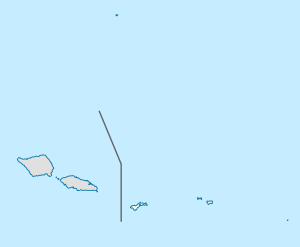Tula | |
|---|---|
Village | |
| Coordinates: 14°15′10″S 170°33′56″W / 14.25278°S 170.56556°W | |
| Country | |
| Territory | |
| County | Vaifanua |
| Area | |
| • Land | 0.51 sq mi (1.3 km2) |
| Population (2010) | |
| • Total | 405 |
| • Density | 794.5/sq mi (306.8/km2) |
Tula is a village in the Eastern District of Tutuila Island in American Samoa. Tula is located in Vaifanua County and had a population of 405 as of the 2010 U.S. Census.[1]
Tula is located on Cape Matātula. It is the site of the former upland ridge settlement of Lefutu (AS-21-002).[2]
Geography[edit]
Tula is the easternmost village on Tutuila Island,[3][4] and is situated on the rugged northeast cape of Matātula.[5] It is home to wide, white sand beaches and a prehistoric quarry. The Samoa Observatory, established in 1974 by National Oceanic and Atmospheric Administration (NOAA), sits on Cape Matātula just outside the village of Tula.[6] NASA's Advanced Global Atmospheric Gases Experiment (AGAGE) measures more than 40 trace gases involved in stratospheric ozone depletion, climate change, and air quality at the observatory.[7]
Cape Matā'ula and the nearby village of Onenoa feature small plantations, high cliffs, and forested slopes.[8]
Demographics[edit]
| Year | Population[9] |
|---|---|
| 2010 | 405 |
| 2000 | 413 |
| 1990 | 423 |
| 1980 | 347 |
| 1970 | 329 |
| 1960 | 340 |
| 1950 | 261 |
| 1940 | 104 |
| 1930 | 128 |
History[edit]
Tula was one of the first settlements on Tutuila, having been settled by 600 BCE.[10][11] Numerous ancient artifacts have been discovered at the prehistoric quarry near the town.[12]
References[edit]
- ^ Census of population and housing (2000): American Samoa Summary Social, Economic, and Housing Characteristics (2000). DIANE Publishing. Pages 13 and 147. ISBN 9781428985490.
- ^ Krämer, Augustin (2000). The Samoa Islands. University of Hawaii Press. Pages 497-498 and 432. ISBN 9780824822194.
- ^ Lonely Planet (1990). Samoa: Western & American Samoa. Lonely Planet Publications. Page 148. ISBN 9780864420787.
- ^ Swaney, Deanna (1994). Samoa: Western & American Samoa: a Lonely Planet Travel Survival Kit. Lonely Planet Publications. Page 178. ISBN 9780864422255.
- ^ Krämer, Augustin (2000). The Samoa Islands: An Outline of a Monograph With Particular Consideration of German Samoa. University of Hawaii Press. Page 432. ISBN 9780824822194.
- ^ Stanley, David (2004). Moon Handbooks South Pacific. Page 479. ISBN 9781566914116.
- ^ "Cape Matatula". Advanced Global Atmospheric Gases Experiment. NASA. Retrieved 12 April 2022.
- ^ Swaney, Deanna (1994). Samoa: Western & American Samoa: a Lonely Planet Travel Survival Kit. Lonely Planet Publications. Page 178. ISBN 9780864422255.
- ^ "American Samoa Statistical Yearbook 2016" (PDF). American Samoa Department of Commerce.
- ^ Lonely Planet (1990). Samoa: Western & American Samoa. Lonely Planet Publications. Page 135. ISBN 9780864420787.
- ^ Stanley, David (1999). Moon Handbooks Tonga-Samoa. Moon Travel Handbooks. Page 163. ISBN 9781566911740.
- ^ Murrow, Tony and Malama Meleisea (2000). Samoa: Pacific Pride. Pasifika Press. Page 42. ISBN 9780908597192.
